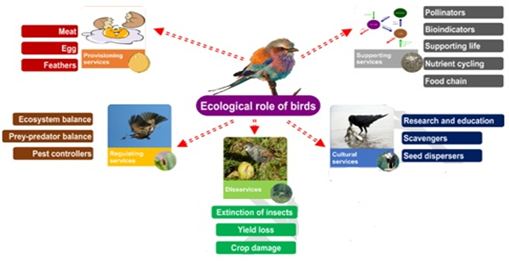Threats and Anthropogenic Influence on the Biodiversity of Birds in Urban Ecosystem
DOI:
https://doi.org/10.5281/zenodo.10655045Keywords:
urbanization, covering, diversity, bird community, natural areas, ecosystem, anthropogenicAbstract
In order to accommodate the growing human population, urbanization is spreading quickly over the world, but it is drastically affecting the local flora and fauna. The current study was conducted in and around the Chhattisgarh city of Bilaspur, covering a three-stage urbanization gradient. During the COVID-19 pandemic, observations were conducted at the three sites that were chosen between September 2019 and February 2021. Bird surveys employed the point count approach, while measures of sound pressure, or noise, were taken at each of the three sites that were chosen. The Shannon-Wiener diversity index, Fisher's alpha diversity index, and total species richness were used to calculate the avian diversity. The urban center had the highest sound pressure and the lowest bird species richness; however, as we moved out into the countryside, the noise levels dropped and the bird species richness rose. This is mostly because urban settings are becoming less attractive to many bird species due to increased noise levels. Additionally, we discovered that the diversity of the urban bird community was far lower than that of the rural one, with only a few dominant species.
Downloads
References
Wadatkar, JS. (2001). Checklist of birds from Amravati university campus, Maharashtra. Zoos Print Journal 16(5), 497-499.
Slabbekoorn H., & Ripmeester EAP. (2008). Birdsong and anthropogenic noise: Implications and applications for conservation. Molecular ecology, 17(1), 72-83.
Turrini T., & Knop E. (2015). A landscape ecology approach identifies important drivers of urban biodiversity. Global change biology 21(4), 1652-1667.
Ramaiah M., & Avtar R. (2019). Urban green spaces and their need in cities of rapidly urbanizing India: A review. Urban Science, 3(3), 94.
Perillo A, Mazzoni L G., Passos LF., Goulart VD., Duca C., & Young RJ. (2017). Anthropogenic noise reduces bird species richness and diversity in urban parks. Ibis, 159(3), 638-646.
Ortega, CP. (2012). Chapter 2: Effects of noise pollution on birds: A brief review of our knowledge. Ornithological monographs, 74(1), 6-22.
Kale M, Ferrante M., Dudhe N., Kasambe R., Trukhanova IS., Ivanova T., & Lövei GL. (2018). Nestedness of bird assemblages along an urbanisation gradient in Central India. Journal of Urban Ecology, 4(1).
Rather HA., & Shrivastava P. (2021). Status of avifaunal diversity in bhoj wetland Bhopal, Madhya Pradesh, India. Journal of Entomology and Zoology Studies, 9(6), 89-92.
Konadath S, Mahadeva A., & Chatni S. (2019). Noise measurement across different land-use patterns. Journal of Indian Speech Language & Hearing Association, 33(2), 55.
Garima Tiwari., & Fergus Mark Anthony. (2022). Anthropogenic noise reduces bird species richness and diversity along a Rur-urban gradient: A case study from a city in central India during nationwide lockdown amid COVID-19. Journal of Biodiversity and Environmental Sciences (JBES), 20(1), 1-9.

Downloads
Published
How to Cite
Issue
Section
ARK
License
Copyright (c) 2023 Dr. Gargi

This work is licensed under a Creative Commons Attribution 4.0 International License.
Research Articles in 'Applied Science and Engineering Journal for Advanced Research' are Open Access articles published under the Creative Commons CC BY License Creative Commons Attribution 4.0 International License http://creativecommons.org/licenses/by/4.0/. This license allows you to share – copy and redistribute the material in any medium or format. Adapt – remix, transform, and build upon the material for any purpose, even commercially.










